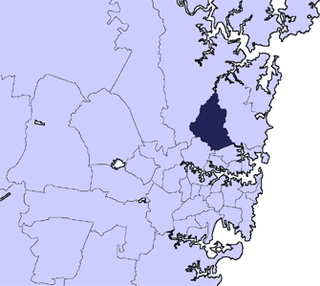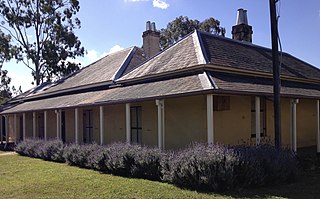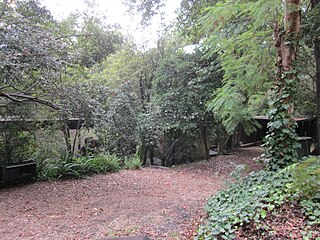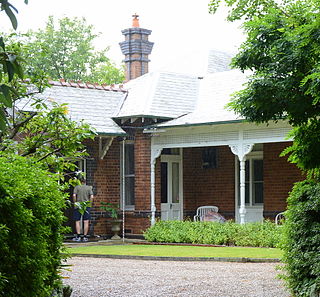
Ku-ring-gai Chase National Park is a national park on the northern side of Sydney in New South Wales, Australia. The 14,977-hectare (37,010-acre) park is 25 kilometres (16 mi) north of the Sydney central business district and generally comprises the land east of the M1 Pacific Motorway, south of the Hawkesbury River, west of Pittwater and north of Mona Vale Road. It includes Barrenjoey Headland on the eastern side of Pittwater.

Ku-ring-gai Council is a local government area in Northern Sydney, in the state of New South Wales, Australia. The area is named after a fictional Aboriginal language group.

Warrawee is a suburb on the Upper North Shore of Sydney in the state of New South Wales, Australia. Warrawee is located 17 kilometres north-west of the Sydney Central Business District, in the local government area of Ku-ring-gai Council. Warrawee is predominantly a residential suburb with few commercial entities. Notably, its railway station supports no commercial activities, which is uncommon on the Sydney train network.

Turramurra is a suburb on the Upper North Shore of Sydney, in the state of New South Wales, Australia. It is located 16 kilometres (10 mi) north-west of the Sydney central business district, in the local government area of Ku-ring-gai Council. It shares the postcode of 2074 with the adjacent suburbs of North Turramurra, South Turramurra and Warrawee.

North Turramurra is a suburb on the Upper North Shore of Sydney, in the state of New South Wales, Australia. North Turramurra is located 20 kilometres (12 mi) north-west of the Sydney central business district, in the local government area of Ku-ring-gai Council. Turramurra and South Turramurra are separate suburbs.

Bobbin Head is a point on Cowan Creek in the north of the suburb of North Turramurra, New South Wales, Australia. It is a "near-urban" part of Ku-ring-gai Chase National Park. Bobbin Head is easily reached by taking Bobbin Head Road through North Turramurra or Kuringai Chase Road, Mount Colah near Hornsby.

Vaucluse House is a heritage-listed residence, colonial farm and country estate and now tourist attraction, house museum and public park, formerly the home of statesman William Charles Wentworth and his family. It is located at 69a Wentworth Road, Vaucluse in the Municipality of Woollahra local government area of New South Wales, Australia. Completed between 1803 and 1839 in the Gothic Revival style, its design was attributed to W. C. Wentworth and built by Sir Henry Browne Hayes and W. C. Wentworth. The property is owned by the Historic Houses Trust of New South Wales, an agency of the Government of New South Wales. The site was added to the New South Wales State Heritage Register on 2 April 1999.

Canning Downs was the first residential establishment built by a white person on the Darling Downs in Queensland, Australia. It is located a short drive from the town of Warwick and originally extended south east to Killarney and the McPherson Range. The area was first named after the British statesman George Canning by Allan Cunningham.

The Hermitage is a heritage-listed residence and former research institute and government office located at 1–13 Pennant Avenue, Denistone in the City of Ryde local government area of New South Wales, Australia. It was possibly designed by architect John Bibb and built from 1838 to 1842 in the Australian colonial Victorian era style. It is also known as The Hermitage and Garden. The property is privately owned. It was added to the New South Wales State Heritage Register on 2 April 1999.

Llanarth is a heritage-listed residence at 120 Eglinton Road, Llanarth, Bathurst Region, New South Wales, Australia. It was built from 1858 to 1864, the original house by W. Atkins and the 1864 alterations by John Smith. The 1907 stables were designed by J. J. Copeman. It is also known as Strathden and Stratheden. It was added to the New South Wales State Heritage Register on 2 April 1999.

Addington House is a heritage-listed former farm, residence and orchard and now community facility located at 813 Victoria Road, Ryde, New South Wales, Australia. It was built from 1794 to 1841 in different stages by James Stewart, James Shepherd, Thomas Bowden. It is also known as New Farm. The property is owned by City of Ryde. It was added to the New South Wales State Heritage Register on 2 April 1999.

Riverview House is a heritage-listed former orchard and now residence at 135 Marsden Road, West Ryde in the City of Ryde local government area of New South Wales, Australia. It was built from 1860 to 1878 by George Spurway. The property is privately owned. It was added to the New South Wales State Heritage Register on 2 April 1999.

Woodlands is a heritage-listed residence at 1 Werona Avenue, in the Sydney suburb of Killara in the Ku-ring-gai Council local government area of New South Wales, Australia. It was designed by Henry Austin Wilshire, and built from 1884. It is also known as Inglewood; Inglenook. The property is privately owned. It was added to the New South Wales State Heritage Register on 13 October 2006.

The Jack House is a heritage-listed domestic dwelling at 62 Boundary Road, in the Sydney suburb of Wahroonga in the Ku-ring-gai Council local government area of New South Wales, Australia. It was designed by Russell Jack and Pamela Jack and built from 1956 to 1957 by Donald W. Taylor. It was added to the New South Wales State Heritage Register on 24 June 2013.

Tulkiyan is a heritage-listed former suburban residence and former house museum at 707 Pacific Highway, in the Sydney suburb of Gordon in the Ku-ring-gai Council local government area of New South Wales, Australia. It was designed by Bertrand James Waterhouse of Waterhouse and Lake, and built by Mr Ochs; garden laid out by Mr Mottram. The property is owned by Ku-ring-gai Council. It was added to the New South Wales State Heritage Register on 27 May 2005.

The Briars is a heritage-listed residence located at 14 Woonona Avenue, in the Sydney suburb of Wahroonga, New South Wales, Australia. It was designed by Charles H. Halstead. It was added to the New South Wales State Heritage Register on 2 April 1999.

Cossington is a heritage-listed residence located at 43 Ku-Ring-Gai Avenue, in the Sydney suburb of Turramurra, New South Wales, Australia. It was designed by Nixon and Allen and built in 1899. It is also known as Sylvan Fells and Sylvan Falls. The property is privately owned. It was added to the New South Wales State Heritage Register on 18 August 2006.

The Eric Pratten House is a heritage-listed residence located at 29 Telegraph Road in the Sydney suburb of Pymble in the Ku-ring-gai Council local government area of New South Wales, Australia. It was designed by Walter Burley Griffin and built from 1935 to 1936. It is also known as Coppins and Crompton. It was added to the New South Wales State Heritage Register on 22 December 2000.

Iolanthe is a heritage-listed former residence and post office located at 691 Pacific Highway in the Sydney suburb of Gordon in the Ku-ring-gai Council local government area of New South Wales, Australia. It was built in 1870. It is also known as Gordon Post Office. The property is owned by the Uniting Church in Australia and is within the perimeter fence of the Ravenswood School for Girls. It was added to the New South Wales State Heritage Register on 2 April 1999.

St John's Uniting Church is a heritage-listed Uniting church located at Coonanbarra Road in the Sydney suburb of Wahroonga in the Ku-ring-gai Council local government area of New South Wales, Australia. Established as a Presbyterian church, the building was designed by John Shedden Adam and built from 1929 to 1930. It is also known as St. John's Uniting Church, Hall and Manse, Knox Church, Wahroonga Presbyterian Church, St John's Presbyterian Church, WPS and Wahroonga Preparatory School. The property is owned by the Uniting Church in Australia. It was added to the New South Wales State Heritage Register on 19 September 2003.
























